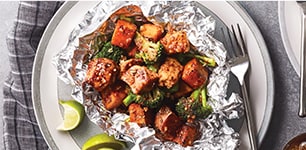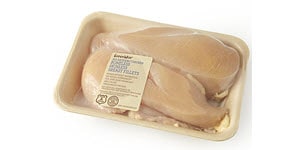Updated June 4, 2021
It’s always tempting to try the latest eating styles, such as the paleo diet or keto diet, to help lose weight or achieve certain health goals. In the short term, these trendy diets may help you lose weight, but following them for the long term may not be ideal for your overall health.
Let’s explore the paleo and keto eating styles from a dietitian’s perspective, considering foods to include and avoid, and how to maintain nutritional balance. Before you start any new diet or eating plan, be sure to consult your physician to make sure it’s right for you.

How to navigate the paleo diet.
A paleo dietary plan features foods that prehistoric humans may have eaten during the Paleolithic era.1 It’s based on the belief that, if early humans didn’t eat it, neither should you.2 Say goodbye to refined sugars, dairy, legumes, and grains, which are products of the agricultural revolution. Say hello to meat, fish, poultry, fruits, veggies, nuts, and seeds, foods that were hunted and gathered.1, 3
| What's In4, 5 | What's Out4, 5 |
|---|---|
|
|
| Pros1, 2 |
|---|
|
| Cons1, 2 |
|---|
|
7 smart paleo diet tips.
If you decide to try a paleo-style diet, check out these ideas to help you maintain balanced nutrition along the way.
- Focus on lean meats. For red meats—such as beef, pork, and lamb—look for round or loin in the name. GreenWise chicken fillets, cutlets, and tenderloins are raised without antibiotics ever on a 100% vegetarian diet. Try our grass-fed beef and cage-free eggs.
- Include fish that contain omega-3s, such as salmon, trout, oysters, crab, mussels, catfish, clams, and flounder.8 Our Seafood department has you covered.
- Save time with carb alternatives such as spiralized veggies (available in Produce and frozen foods) and riced cauliflower (in frozen foods).
- Find sources of calcium beyond dairy, such as turnip greens, kale, canned salmon, and sardines with bones.9
- Get vitamin D from foods such as salmon, canned tuna, and eggs.10
- Add fiber to salads and soups with chia, flax, sunflower, and pumpkin seeds as well as nuts like almonds and pistachios. Our GreenWise almond butter is another great option.
- Talk to your doctor about adding a supplement if needed.
Whether you’re going paleo or not, try our Smoky Chicken and Vegetables recipe, featuring chicken, broccoli, and sweet potatoes.
What to know about the keto diet.
The keto eating style is rooted in a decades-old therapeutic ketogenic diet used in neurological medicine. Today, several versions of the keto diet appear in books, blogs, and social media. Common threads include high-fat foods coupled with very low carbs and moderate proteins. Most keto diets suggest a daily calorie split of 70–80% fats, 5–10% carbohydrates, and 10–20% proteins.11
| What's In11 | What's Out11 |
|---|---|
|
|
| Pros11 |
|---|
|
| Cons11, 12 |
|---|
|
5 ways to work with keto.
If you decide to try a keto-style diet, be sure to follow these guidelines.
- Get familiar with the “good” fats: polyunsaturated and monounsaturated fats.13
- Find polyunsaturated fats in walnuts and pine nuts as well as in flax, sesame, and pumpkin seeds. Omega-3 fatty acids (a type of polyunsaturated fat) are plentiful in seafood, such as salmon, trout, oysters, crab, mussels, catfish, clams, and flounder,8 and in flaxseeds and walnuts.
- Discover monounsaturated fats in olive oil, avocados, and most nuts.
- Experiment with pasta alternatives such as spiralized, precut, and riced veggies, located in our Produce department and in frozen foods.
- Learn about hidden sources of added sugars.
- Add fiber to your diet with chia seeds, flaxseeds, nuts, and vegetables. Consider taking a fiber supplement as recommended by your physician.
- Learn how to track your macronutrients, or macros—the fats, proteins, and carbs that comprise your daily calorie intake. Here’s how:
- Determine how many total calories per day you should consume to lose weight.
- Take that total and divide it by the macro percentages you are trying to reach.
- Use the chart below to help determine your macros based on your calorie level.
- Set goals and use a weight loss or food tracking app.
Sample Guidelines
| Calories | 70% fat (in grams) |
20% protein (in grams) |
10% carbohydrates (in grams) |
|---|---|---|---|
| 1500 | 117 | 75 | 38 |
| 1800 | 140 | 90 | 45 |
| 2000 | 156 | 100 | 50 |
| 2200 | 171 | 110 | 55 |
New recipe! Add international zing to your keto diet with Chicken with Zhoug-Style Sauce featuring Publix chicken, broccoli, and a blend of herbs and spices.
For the Love of You
Choosing how you eat is uniquely personal. It’s about your needs, your preferences, and your goals. As your wellness ally, we're in your corner with fresh ideas, recipes, and wellness icons that make it easier to shift toward wiser food choices. It’s all about you, at your very best.
Sources
1 Mayo Foundation for Medical Education and Research (MFMER). Paleo Diet: What Is It and Why Is It So Popular? Mayo Clinic. August 25, 2020.
2 What Is the Paleo Diet? U.S. News & World Report. Accessed April 5, 2021.
3 Amidor, Toby, MS, RD, CDN. Paleo: Spotlight on the Paleo Diet. Today's Dietitian 20, no. 2 (February 2018): 14.
4 The Paleo Diet Team. What You Should and Should Not Eat on The Paleo Diet. The Paleo Diet. December 28, 2020.
5 Paleo Diet Do’s & Don’ts. U.S. News & World Report. Accessed April 5, 2021.
6 The Paleo Diet Team. Q&A: Are Sweet Potatoes Paleo? The Paleo Diet. February 10, 2010.
7 Manheimer, Eric W., Esther J. van Zuuren, Zbys Fedorowicz, and Hanno Pijl. Paleolithic Nutrition for Metabolic Syndrome: Systematic Review and Meta-Analysis. The American Journal of Clinical Nutrition 102, no. 4 (October 2015): 922-32.
8 Which Fish Is the Richest in Omega-3s? Seafood Nutrition Partnership. Image. Accessed April 5, 2021.
9 U.S. Department of Health & Human Services (HHS). Calcium Fact Sheet for Health Professionals. National Institutes of Health (NIH): Office of Dietary Supplements. October 16, 2019.
10 U.S. Department of Health & Human Services (HHS). Vitamin D Fact Sheet for Health Professionals. National Institutes of Health (NIH): Office of Dietary Supplements. August 7, 2019.
11 The President and Fellows of Harvard College. Diet Review: Ketogenic Diet for Weight Loss. Harvard T. H. Chan School for Public Health. Accessed April 5, 2021.
12 Bueno, Nassib Bezerra, Ingrid Sofia Vieira de Melo, and Terezinha da Rocha Ataide. Very-Low-Carbohydrate Ketogenic Diet v. Low-Fat Diet for Long-Term Weight Loss: A Meta-Analysis of Randomised Controlled Trials. British Journal of Nutrition 110, no. 7 (October 14, 2013): 1178-87.
13 U.S. Department of Health & Human Services (HHS). Dietary Fats: The Basics. 2015–2020 Dietary Guidelines for Americans, 8th ed. November 21, 2016.

 You are about to leave publix.com and enter the Instacart site that they operate and control. Publix’s delivery and curbside pickup item prices are higher than item prices in physical store locations. Prices are based on data collected in store and are subject to delays and errors. Fees, tips & taxes may apply. Subject to terms & availability. Publix Liquors orders cannot be combined with grocery delivery. Drink Responsibly. Be 21. For prescription delivery, log in to your pharmacy account by using the Publix Pharmacy app or visiting
You are about to leave publix.com and enter the Instacart site that they operate and control. Publix’s delivery and curbside pickup item prices are higher than item prices in physical store locations. Prices are based on data collected in store and are subject to delays and errors. Fees, tips & taxes may apply. Subject to terms & availability. Publix Liquors orders cannot be combined with grocery delivery. Drink Responsibly. Be 21. For prescription delivery, log in to your pharmacy account by using the Publix Pharmacy app or visiting 


